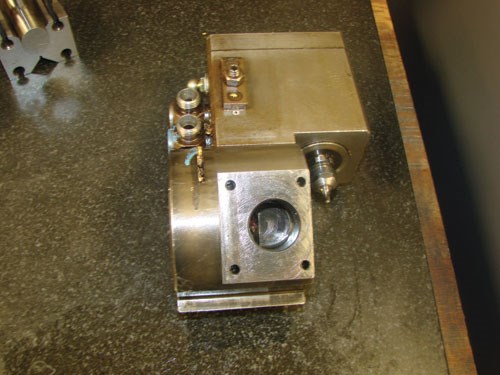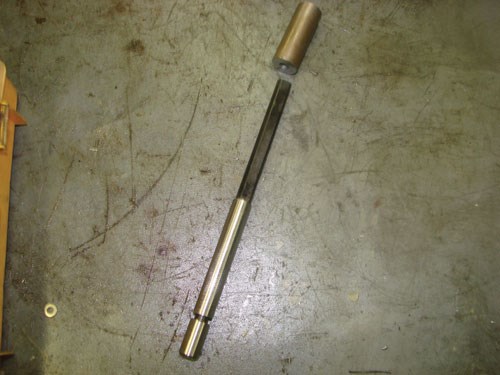Refining the Process Saves Time and Money
Sometimes it isn’t just the part, but the process that makes all the difference, especially when it comes to meeting deadlines and customer demands.For any manufacturer, customer satisfaction is the number one concern.
Sometimes it isn’t just the part, but the process that makes all the difference, especially when it comes to meeting deadlines and customer demands.
For any manufacturer, customer satisfaction is the number one concern. For Kris Fugate, V.P. of D&S Machine Products Inc. in Aurora, Ind., this requires tight timing, quality parts and cost effective solutions. When a new client needed an air valve body part ASAP, D&S Machine needed to start working on the part on its Hydromat rotary transfer immediately. The cog in the wheel was the center block, essential for the cross drilling units and ultimately for producing the part on time.
“Our original estimated lead time for getting the center block was 6 weeks. We needed it in 3 weeks or less to meet our client launch date,” Mr. Fugate says.
This family-owned and operated business began in 1983 in a three-car garage with two Davenport machines. The company has grown into a 40,000-square-foot facility with nine Hydromat rotary transfer machines and 30 Acme and Davenport multi-spindle machines producing precision metal components for aerospace, appliance, hydraulic, fluid control and agricultural industries.
At this point, it would take too long to get the center block for the Hydromat. So Mr. Fugate turned to Core Powered Inc., a collaborative company specializing in value-add manufacturing, consulting and process management, who turned the part around in 2 weeks at half the cost.
The company was able to do this by looking at all the information and determining it wasn’t a matter of replacing the center block, but looking at the process behind it.
Traditionally, center blocks are produced with a very tight tolerance. “The tighter the tolerance, the longer it takes to make a part,” Mr. Fugate explains.
Core Powered, through its three-tiered process of assessing all aspects of a job, not just the part alone, determined that “the over-engineered parts of the center block could be taken out of the equation,” says Charles Ruecker, founder of the company. “For D&S it was a matter of looking at the situation, assessing how the center block currently worked and presenting a different way to think about the result.”
Mr. Ruecker and Core Powered gave D&S two options—either make the part exactly to print or eliminate some of the unnecessary tight tolerance features incorporated in the current design. They chose the latter. The new center blocks arrived on time and resulted in reduced setup costs and a happy client.
“Core Powered was able to cut some lead time out just by knowing the product and what it does,” Mr. Fugate says. “When you are starting up with a customer, you need all your suppliers to come through. And they definitely came through for us.”
The process, called The Manufacturing Solution, is based on three key components. The first is “Human Manufacturing,” which focuses on the thought process behind the job, asking the right questions and determining how to look at the project differently. Next is formulating the process, or creating the blueprints for success based on what is determined through the “Human Manufacturing” stage. The last stage is applying the process and manufacturing the parts. Normally, these three components are separate. With The Manufacturing Solution, the three services are combined so that one company handles it all.
“Core Powered helps customers simplify by acting as a process advisor and a consultant, not just a parts manufacturer,” Mr. Ruecker says. By melding the three services into one touch point, the company provides customers a team of experienced professionals that can assess, process and produce.
“A lot of people think that there is a standard solu-tion—one part to every problem. But that’s not the box creativity lives in,” Mr. Ruecker says. “Every situation is different, and that one solution doesn’t exist.”
“In our business, things are always changing,” Mr. Fugate says. “You need flexible options in order to get a job done, and that is what Core Powered gives us.”
When D&S was faced with another client challenge—producing electrical components in a cost-effective and timely manner—Mr. Fugate turned to the company again.
Since this was a family of parts with different lengths, it initially appeared they would need different ejector rods and tips to produce each part: a costly, time consuming and labor intensive process.
After assessing the initial plans, speaking with Mr. Fugate and his team, and clarifying a process, Mr. Ruecker and Core Powered standardized the rods for the replaceable custom tips that can be used for each individual part. “This process has cut costs and setup time significantly because you don’t have to take the rods all the way out. You just take the tips off,” Mr. Fugate says.
Standardizing the ejector rods eliminated the extra cost of individually specifying each piece, designing them, keeping them in inventory and ultimately re-purchasing as needed. “We consolidated the process,” Mr. Ruecker says. “We helped them with the process to standardize this custom piece, and now they will never have to buy that again.”
D&S has been running the standardized rods for 3 months on two of its Hydromats and has plans to put them into all of the company’s machines each time a new job is set up.
“In our industry if you want to be a good supplier you have to do what you say — deliver on time and be cost competitive,” Mr. Fugate says. “And (for us) this means working with Core Powered, combining its knowledge with ours and coming up with the best, cost-effective, time sensitive solutions for our clients.”
D&S’ success is not just about manufacturing the parts—it’s about the relationship with its customers.
Related Content
What Is Trochoidal Turning? How Might Shops Benefit From It?
While trochoidal milling might be a more well-known toolpath strategy, trochoidal turning can offer similar benefits such as high material removal rates especially for rough-turning operations.
Read MoreShop Sets its Sights on Precise Tool Alignment
A Wisconsin shop has found that visual tool alignment technology has improved tool life and surface finishes for its Swiss-type lathes while increasing throughput as well.
Read MoreGerman Project Yields Three New Medical Machining Processes
Recent research has resulted in a new mix of high-speed turn whirl milling, polygon turning and rotational turning for manufacturing medical bone screws and out-of-round nails.
Read MoreAutomation Breakthroughs Revolutionize Precision Machining for Complex Parts
Marubeni Citizen-Cincom delivers custom solutions to address some of the biggest challenges in precision machining from handling small parts, to robot integration and unique tooling needs.
Read MoreRead Next
Specialty Company Knows Its Collets
For almost 3 years Mr. Bouchard struggled with a machine application designed to produce life-critical airbag parts for Arrow Machine’s primary client in the automotive industry. With the help of RH Collets, a manufacturer of specialty workholding and related components for Hydromats and other machinery, Mr. Bouchard is solving the problem—not with one new part but with a series of solutions.
Read MoreDo You Have Single Points of Failure?
Plans need to be in place before a catastrophic event occurs.
Read More
















.jpg;maxWidth=300;quality=90)






